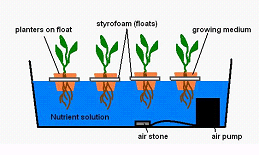Hydroponic gardening is not stuff made for rocket scientists. It ranges from the most simple sets up for the home gardener right up to complex structures that huge hydroponic farms use. One thing that is a common fixture for both is that you get crops that provide you with a higher yield in terms of growth volume and frequency. This is because plants grown hydroponically are supplied with all the required nutrients and do not have to content with each other (other plants in the same bed) for the same nutrients.
They are also not overtly concerned with developing the root system, so most nutrients is concentrated on the growth of foliage and blooms. There are two types of hydroponic system: passive and active, and within these two categories you have several types of systems. These are: Flood and Drain (or Ebb and Flow), Deep Water Culture (DWC), Drip feeding, Wick feeding, Nutrient Film Technique (NFT), and Aeroponics. This article touches on the construction of a DIY Deep Water Culture system.

Figure 1. A simple DWC hydroponic system
Deep Water Culture (DWC)
In Deep water culture (DWC) system the plant is basically suspended in the solution of nutrient rich oxygenated water by means of a floater (such as a Styrofoam). You should begin this type of system by cultivating your plants in rock wool growing medium before transferring them onto the floaters to be placed into the reservoir with nutrient solution.
Tools and materials
- Airline/tubing with airstones
- Reservoir (water proof bin, bucket, or fish tank)
- StyroFoam
- Air pump (submersible)
- Net Pots
- Rockwool or grow rocks as growing medium
- Hydroponics nutrients (Grow fertilizers, Bloom fertilizers, Supplements, pH)
- Knife, box cutter or scissors
- Measure the reservoir that you will be using and transfer this measurement onto the piece of Styrofoam that you will be using as a floater. You can choose to either cut out individual floaters for each plant (like illustrated in Figure 1) or have a whole piece floating on top of the nutrient solution.
- If you choose the second option, measure the length and the width of the reservoir and transfer this measurement onto the Styrofoam piece. Cut about 1/4″ (inch) smaller than the measurement marked. If the reservoir tapers at the bottom, make a cut about 2 to 4 inch smaller.
- Trace the net pots onto the Styrofoam and cut out the marked area. This should be snug enough so that the net pots sit halfway down the Styrofoam.
- Install the submersible air pump at the bottom of the reservoir. Attach the air tube and air stone to the pump.
- Once the seeds have germinate, transfer them onto the planters/net pots into the growing medium (rockwool/grow rocks).
- Fill the reservoir with hydroponic nutrient solution following the correct specification to the type of plants you are growing.
- Then place the net pots into the holes you cut into the Styrofoam and float the Styrofoam on top of the solution.
- Turn on the pump.
Your Deep Water Culture hydroponic system is complete.
Keep an eye on the nutrient, pH and oxygen level of your nutrient solution and top-up occasionally to ensure that your plants are getting the right amount. Deep water culture allows the plant roots to absorb oxygen while also allowing the uptake of nutrients. It is this reason why the plants experience rapid growth.
The nutrient solution should be replaced approximately once a week. The reservoir that you use should be washed with hot water to remove any trace of algae, mould or salt deposits. The solution in the reservoir should be between 5.5 and 6.8. The pH level should be constantly monitored. Because you are promoting a very well-oxygenated and environment which promotes the development of algae, spray paint the reservoir in black to stop light from entering the media to prevent this.
More Reading:
The Deep Water Culture Design, Materials and Methods: http://www.instructables.com/id/SC3557FFJIVOROD/
Marijuana Grow Basics: The Easy Guide for Cannabis Aficionados



